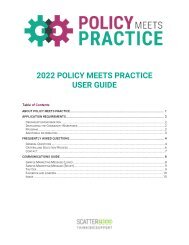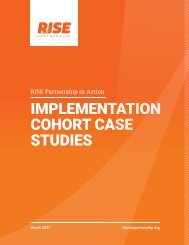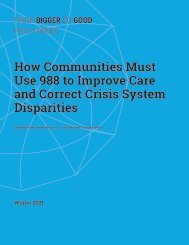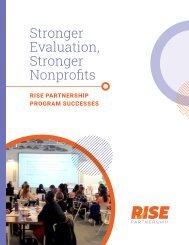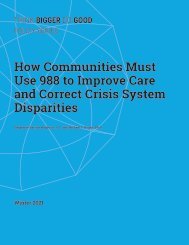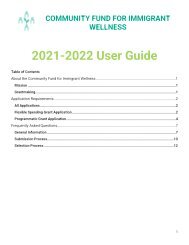Policy_and_Practice_Innovations_Childrens_Prescribing
Create successful ePaper yourself
Turn your PDF publications into a flip-book with our unique Google optimized e-Paper software.
1<br />
Introduction<br />
Psychoactive medications are the most expensive <strong>and</strong> fastest-growing class<br />
of pharmaceutical agents for children. The four drugs prescribed to children with<br />
the highest Medicaid cost are all psychoactive medications (1, 2). Stimulants<br />
alone account for 20.6% of all pediatric drug expenditures. At the same time,<br />
psychoactive medications have extensive <strong>and</strong> expensive side effects <strong>and</strong><br />
frequently have minimal monitoring. For example, although metabolic monitoring<br />
through laboratory assessments is recommended for all children <strong>and</strong> adolescents<br />
taking antipsychotics, less than one-fifth of children receive such monitoring (1).<br />
Studies of prescribing practices <strong>and</strong> their costs, both economically <strong>and</strong> medically,<br />
have raised concerns among clinicians, patient advocates, <strong>and</strong> agencies<br />
with accountability for insuring children <strong>and</strong> adolescents that psychoactive<br />
medications are often used inappropriately.<br />
We briefly review prescribing for three classes of<br />
psychoactive drugs—stimulants, antidepressants,<br />
<strong>and</strong> antipsychotics—<strong>and</strong> then discuss current<br />
system approaches to improving appropriateness<br />
of prescribing.<br />
Here, we briefly review prescribing for three classes of psychoactive drugs—<br />
stimulants, antidepressants, <strong>and</strong> antipsychotics—<strong>and</strong> then discuss current system<br />
approaches to improving appropriateness of prescribing. System approaches<br />
include monitoring guideline concordance or lack thereof, <strong>and</strong> new but untested<br />
pharmaceutical policies <strong>and</strong> implementation of prescribing strategies to improve<br />
appropriateness. Inappropriate prescribing is difficult to define except on a<br />
case-by-case basis. Therefore, we refer to the broader category of potentially<br />
inappropriate prescribing as “questionable prescribing practices.” Both refer to the<br />
prescription of drugs in patterns that appear incongruous with clinically accepted,<br />
evidence-based guidelines. (For convenience, we sometimes use the word<br />
“children” to refer to children <strong>and</strong> adolescents.)<br />
<strong>Policy</strong> <strong>and</strong> <strong>Practice</strong> <strong>Innovations</strong> to Improve <strong>Prescribing</strong> of Psychoactive Medications for Children 7





